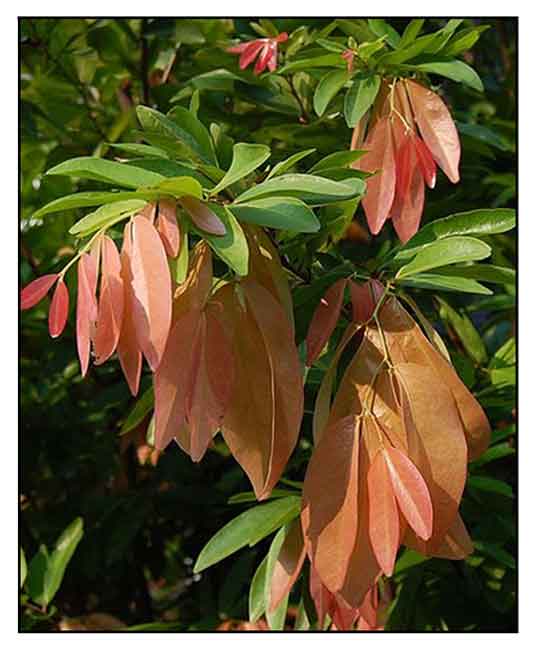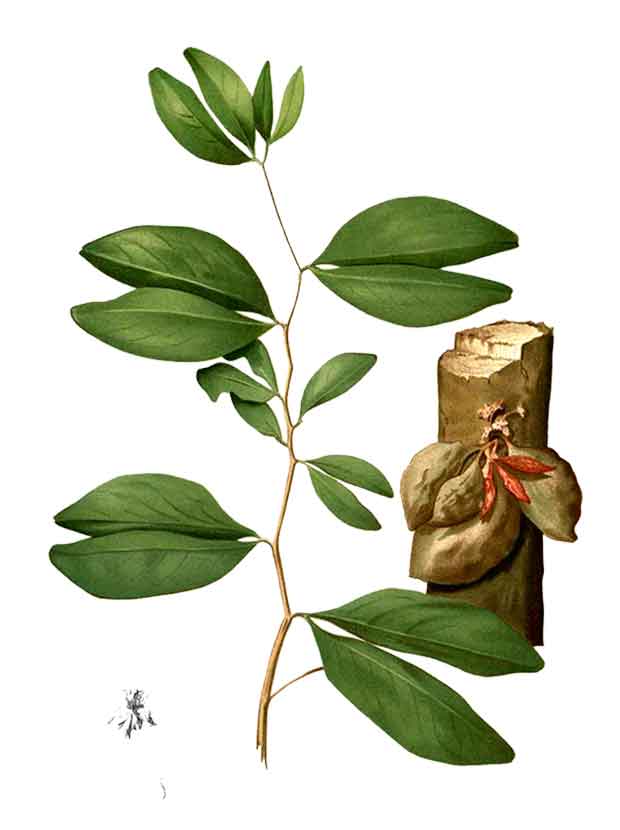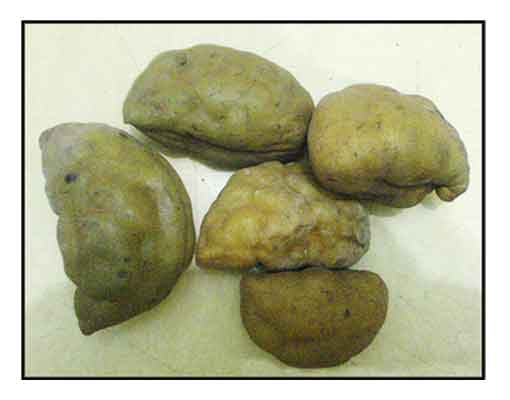 Gen info Gen info
- Genus Cynometra is pantropical and consists of about 150 species, most occurring in South America, about 20 within Malesia, and some in New Guinea.
-
Etymology:
The genus name derives from Greek: 'cyon, cynós' meaning dog and 'metra' meaning uterus, referring to the shape of the fruits. The specific epithet derives from Latin: 'caulis' - caul and 'flos, oris' meaning flower, referring to the flowers that grow directly on the trunk. (2)
Botany
Cynometra cauliflora is a shrub or a small evergreen tree very ramified, that usually does not exceed the 8 m of height, with brown-grayish bark. The leaves, on a 0,4-0,8 cm long petiole, are alternate, formed by two oblong-ovate leaflets, asymmetric with respect to the central rib, with obtuse or slightly pointed apex and entire margins, 6-15 cm long and 2-5 cm broad, of glossy dark green color above, pale green below, coriaceous; the young leaves, of bright pink color, drooping, are particularly ornamental. The inflorescences are short compact racemes grouped at the nodes of the trunk or of the main branches, often close to the ground, with small bisexual flowers, of about 0,8 cm of diameter, with calyx usually quadripartite with white-pinkish lobes, about 0,4 cm long and broad, retroflexed, 5 thin white or white-pinkish lanceolate petals, about 0,4 cm long, 8-10 stamina and about 0,5 cm long style. The fruits are reniform legumes with yellowish pulp, edible, 5-10 cm long, 4-5 cm broad and 1,2-3 cm thick, with wrinkly surface of brown green color turning greenish yellow when ripe, containing one seed only, 3,5-6 cm long. (2)
 Distribution Distribution
- Introduced.
- Native to Borneo, Jawa, Malaysia, Sulawesi, Sumatra.
(1)
Constituents
- Phytochemical screening of young leaves, mature leaves, stems and barks showed presence of tannins, saponins, and flavonoids in all parts of C. cauliflora. Cardiac glycosides were present in all except for the stem; terpenoids were present in all except in bark. Total phenolic content in young leaves was 1831,47 GAE mg/g. Flavonoid content in young leaves was 33.63 CE (catechin equivalent) mg/g, (see study below) (3)
- Study of leaf methanolic extract bioactive fractions yielded 18 compounds, comprising a procyanidin trimer, procyanidin tetramer, procyanidin hexamer, taxifolin pentoside, catechin, vitexin, isovitexin, kaempferol hexoside, quercetin pentoside, quercetin hexoside, apigenin-6-C-glucoside-8-C-glucoside, kaempferol-coumaroyl hexoside and isorhamnetin hexoside. (see study below) (4)
- GC and GC/MS study for essential oil yielded 26, 17, and 50 constituents in leaf, twig, and fruit. There was dominance of monoterpenes hydrocarbons in leaf oil and oxygenated monoterpenes in the twig oil, while fruit oil was abundant in oxygenated sesquiterpenes. (see study below) (5)
- Phytochemical screening of methanolic extract of leaves yielded tannins, flavonoid, saponins, cardiac glycosides, and terpenoids. (see study below)
(8)
- LCMS identified the flavonoid compounds as xanthotoxin, fraxetin, capensine, naringenin, malvidin, cyanidin, amorphigenin, nobiletin, isorhamnetin, epigallocathecin, gallate, apigenin and oenin.
(see study below) (9)
- Study of crude extracts and fractions from twigs
yielded pure compounds consisting of three flavones, luteolin (1), acatecin (2), 3',4',7-trihydroxyflavone (3) and one flavanone, eriodictyol (4). (11)
- Study of methanol extract of twigs isolated two known flavones, apigenin (1) and luteolin (2)
Properties
Studies have suggest antioxidant, acetylcholinesterase inhibitory, tyrosinase inhibitory, α-glucosidase inhibitory, cytotoxic, antiviral, antiproliferative, lipase-inhibitory, anti-obesity, hypolipidemic, antibacterial properties.
Parts used
Leaves, seeds, oil.
 Uses Uses
Edibility
- Fruit is edible. Unripe fruits are sour tasting and consumed only cooked; ripe ones are pleasant tasting, consumed fresh, added to salads, fried in batter or cooked with sugar for jams. (2)
Folkloric
- Oil from seeds used for leprosy and skin diseases.
- Leaves used for treatment of diarrhea.
Others
- Wine: Potential of fruit for wine production. (see study below) (15)
- Wood: Low to moderate durability, suitable for interior construction, door or window frames, flooring and interior trim. When treated, used for heavy outdoor construction, poles, beams, railway sleepers, fenders. boat and ship building. Not suitable for veneer or plywood.
- Fuel: Wood makes good quality charcoal.
Studies
• Antioxidant / Leaves: Study evaluated dry sample of young leaves, matured leaves, stems and barks from C. cauliflora for antioxidant activity and phytochemical composition. DPPH radical scavenging activity was in the order or young leaves > mature leaves > stem > bark, compared to ascorbic acid as standard. (see constituents above) (3)
• Antioxidant / Inhibition of Acetylcholinesterase, α-Glucosidase, Tyrosinase Activities / Leaves: Study evaluated the bioactive potential of methanolic leaf extract and fractions in inhibiting enzymes
α-glucosidase, acetylcholinesterase (AChE) and tyrosinase and their antioxidant activities. The leaf methanolic extract exhibited potent inhibition of all three enzymes and high antioxidant activity. (see constituents above) (4)
• Essential Oil / Cytotoxicity / Leaf, Twig, Fruit: Study evaluated the essential oil composition of leaf, twig, and fruit of C. cauliflora and their antioxidant, antimicrobial and cytotoxic activities. Twig oil (IC50 37.12 µg/mL) showed better antioxidant power than the leaf (IC50 207.17 µg/mL) and fruit oils (IC50 461.88 µg/mL) in DPPH assay. Twig oil inhibited an entire range of microorganisms with inhibition zones range of 10.2 to 29.7 mm, with low MIC against S. aureus (MIC 125.0 µg/mL, MBC 250 µg/mL). In invitro MTT assay, twig oil showed antiproliferative effects against human breast cancer MCF-7 cells. (see constituents above) (5)
• Antiviral / Herpes Virus Type-1 / Leaves: Study evaluated Cynometra cauliflora methanolic leaves extract for activity against clinical isolate of herpes simplex virus type-1 (HSV-1). Cytotoxic concentration, CC50 of C. cauliflora extract was 36 mg/mL. High antiviral activity was observed in post-treatment. (6)
• Cytotoxicity / Antiproliferative / Apoptosis / Human Promyelocytic Leukemia HL-60 / Fruit: Study evaluated a methanolic extract of whole fruit for cytotoxicity against human promyelocytic leukemia HL-60 by MTT assay. The CD50 of the extract at 72 hours was 0.9 µg/mL, compared to cytotoxic drug vincristine of 0.2 µg/mL. Extract showed dose dependent inhibition of HL-60 proliferation, with majority of cells in the apoptotic cell death mode. Results showed whole fruit ME was cytotoxic towards HL-60 cells and induced cells into apoptotic cell death mode, and was less cytotoxic towards NIH/3T3 cells. (7)
• Antibacterial / Leaves: Study evaluated methanolic extract of leaves for antibacterial activity against clinical isolated microorganisms. In spot test, antibacterial activity was observed through inhibition zones of bacteria at concentration of 75 and 100 mg/mL, with MICs ranging from 6.25 to 100 mg/mL. Highest value of MIC was shown by MRSA at 6,25 mg/mL. MBC showed no antibacterial activity and showed the extract as bacteriostatic, which ca inhibit the bacterial growth at concentrations less than 100 mg/Ml. Results suggest the ME of leaves can be a potential source of natural antimicrobial agents. (8)
• Lipase Inhibitory Activity / Leaves: In a study of 98 Malaysian plants for their effect on porcine pancreatic lipase activity, kaempferol 3-O-rhamnoside was isolated from the ethyl acetate fraction of C. cauliflora leaves and was found to be an active lipase inhibitor. (9)
• α-Glucosidase Inhibitory Activity / Flavonoids / Leaves: Study reports on n-butanol extraction of flavonoid compounds with potential as α-glucosidase inhibitors. Compounds considered to have α-glucosidase inhibitory activity are fraxetin, oenin, naringenin, malvidin, and cyanidin. Results suggest leaves have the potential for development as a natural therapy for diabetes mellitus through
α-glucosidase inhibition. (see constituents above) (10)
• Antidiabetic / Hypolipidemic / Antioxidant / Leaves: Study evaluated the antioxidative. hypolipidemic, and hypoglycemic potential of C. cauliflora against alloxan induced diabetic rats. Treatment with C. cauliflora extract prevented the biochemical alterations (increased blood sugar, total cholesterol, LDL, increase in MDA, glutathione, and catalase activity) and attenuated alloxan-induced oxidative stress. Activity was attributed to antioxidant and free radical scavenging properties. (12)
• Anti-Obesity / Lipid Lowering Effects / Vitexin / Leaves: Study evaluated the anti-obesity and lipid lowering effects of ethanolic extract of C. cauliflora leaves and its major compound (vitexin) in C57BL/6 obese mice induced by high-fat diet. Oral treatment with extract and vitexin significantly reduced body weight, adipose tissue, liver weight and lipid accumulation in the liver compared to HFD control group. The extract significantly (p<0.05) decreased serum triglycerides, LDL, lipase, IL-6, peptide YY, resistin levels, hyperglycemia, hyperinsulinemia, and hyperleptinemia. There was significant up-regulation of expression of adiponectin, Glut4, Mtor, IRS-1m and InsR genes. Phytochemical analysis of leaves yielded flavonoid, saponin, and phenolic compounds. GC-MS study yielded phytol, vitamin E and ß-sitosterol. Results showed potential agent for obesity management and its related metabolic disorders such as insulin resistance and hyperlipidemia. (13)
• Nam-nam Wine / Fruits: The Nam-nam seasonal fruit has a short shelf-life under tropical conditions. Study evaluated the production of a functional wine from the fruit, preserving its nutraceuticals and health-boosting properties. Formulated Nam-Nam wine was rich in alkaloids, terpenoids, and flavonoids. Sugar content of initial formulation decreased after fermentation and pH increased from 3.8 to 4.4. Results showed a functional wine can be produced from the fruit, which could be more effective in preserving natural nutrients in the original fruit juice. (15)
• Cytotoxicity / HeLa Cells / Leaves: Study evaluated the potential compounds in Namnam leaves extract for cytotoxic activity tested by BLST method and proliferation by using HeLa cancer cells (ATCC CCL-2). Toxicity study showed LC50 was 125.89 µg/mL. Results suggest the extract belongs to the moderate toxic category and has potential as an anticancer agent. The extract at concentration of 25 µg/mL could inhibit the proliferation of HeLa cells by 57.51%. (16)
• Antidiabetic / Antidiarrheal / Leaves: Study evaluated the potential of NamNam as functional food and as antidiabetic and antidiarrheal herbal remedy. The leaf extract at concentration of 100, 250, and 300 mg/mL could inhibit α-amylase activity by 20.68, 70.24, and 72.59% and IC50 of 200 mg/mL. The extract could claos decrease the activity of isolated rabbit intestine. Results showed the plant leaves have potential as antidiabetic and antidiarrheal. (17)
Availability
Wild-crafted.
|

![]()




 Distribution
Distribution
